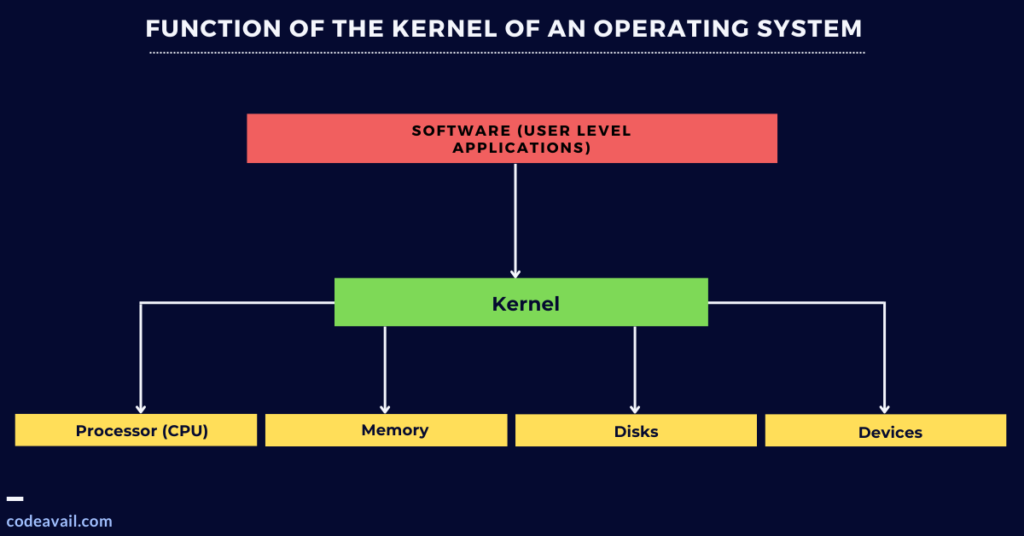If you are a computer geek, then you must have heard the word kernel, which is the central part of an operating system. In other words, Kernel is the heart of the computer system. It is considered the most important element in any computer system, much as the heart is for human beings.
In essence, it is the most important element in a computer system. The Kernel functions much like the blood which transports oxygen and nutrients to the cells of the human body.
Similarly, the Kernel provides services and assistance, much like the blood, to the applications and programs of the operating system. The Kernel, through the drivers and services, provides resources to the computer system. These resources range from drivers, and services, to other computer programs.
This blog will look at how the kernel works, what is the function of the kernel of an operating system, the parts of a kernel, and the development of kernels in operating systems. This post is particularly useful for newbies who want to learn or refresh their knowledge on the subject.
What is Kernel?
Table of Contents
In an operating system, a kernel is a central part that manages hardware and software resources and ensures they are used in the most efficient way. It is the core of the operating system. It handles the basic functions of an OS like scheduling tasks, allocating memory, and managing input and output.
The kernel is the core part of the operating system and it creates a bridge between the user application and the system hardware. It is an essential part of any operating system as it interfaces with the hardware and the software components of the computer.
Windows operating systems have different kernels and they are called NTKernel, Linux Kernel, and FreeBSD Kernel. They are all different and they have several components.
Before we jump into the main part of the article i.e. what is the function of the kernel of an operating system, let us know the different objectives of the kernel.
What is the Objective of the Kernel?
- To allow user-level apps and hardware to communicate with one another.
- To make decisions about the state of incoming processes.
- To keep track of disc usage.
- To be able to handle memory.
- To maintain task management control.
How Does Kernel Work?
The kernel is the core component of an operating system. It acts as the bridge between software and hardware. When you interact with your computer or device, the kernel is responsible for managing and coordinating all the different processes. It allocates resources like memory and CPU time to each program running on your system, ensuring they work smoothly together. The kernel also handles device drivers, enabling communication between software and hardware devices like printers or keyboards. It provides security by enforcing access control and permissions. In essence, the kernel is like the conductor of an orchestra, orchestrating and harmonizing all the different parts of your computer’s system to ensure everything runs efficiently and securely.
Different types of kernel
1. Monolithic Kernels:
A monolithic kernel is an operating system where the features of the kernel are not split into multiple, separate modules. Instead, it is developed all in one piece. The Linux kernel, which is used in many different versions of the operating system and is a good example of one. It’s very different from the more common microkernel architectures, which split the kernel into multiple, separate parts.
Example: Linux, Unix, XTS-400, Open VMS, etc.
Advantage :
Its performance is good.
Disadvantage :
There are millions of lines of code and dependencies between system parts.
2. Microkernel:
A microkernel differs from a monolithic kernel. Here the user and kernel services are implemented in separate zones, i.e. with microkernels, we use User Space and Kernel Space. Because we use User Space and Kernel Space separately, the Kernel is smaller, reducing the operating system’s size.
Because we use different areas for user and kernel services, message parsing is used to communicate between applications and services, slowing down the execution performance.
Example: Mach, AmigaOS, L4, K42, Minix, etc.
Advantage :
It is more stable.
Disadvantage :
There are many system calls and context switches.
3. Hybrid Kernels:
A hybrid kernel is a mix of monolithic and microkernel architectures. It takes advantage of the Monolithic Kernel’s performance and the Microkernel’s modularity.
Hybrid kernels are micro kernels with some “non-essential” code running in kernel space rather than user space to allow the code to execute faster. To avoid the performance overhead, some services, such as the network stack or filesystem, are executed in kernel space, although kernel code is still run as servers in user space.
Example :
BeOS, Netware, Windows NT, etc.
Advantage :
It incorporates both a monolithic kernel and a microkernel.
Disadvantage :
It is still similar to a monolithic kernel.
4. Nanokernel:
As the name implies, the entire kernel code, i.e. the code running in the privileged mode of the hardware, is very small in a Nanokernel. A kernel that supports a nanosecond clock resolution is named a nanokernel.
Example :
EXOS, Nemesis, etc.
Advantage :
It delivers hardware abstractions without system services.
Disadvantage :
It is almost the same as the micro kernel, hence it is less utilized.
5. Exokernel
The MIT Parallel and Distributed Operating Systems group has created Exokernel, an operating system kernel. Resource protection is separated from the management in this kernel type, allowing us to do the application-specific modification.
The aim behind the Exokernel is to avoid implementing all of the abstractions. However, the goal is to impose as few abstractions as possible, with the abstractions only used when necessary. (https://www.secolarievoo.com/) As a result, there will be no force abstraction in the Exokernel, which distinguishes it from monolithic kernels and microkernels. However, the complexity of the design is a disadvantage. The Exokernel has a complicated design.
Example :
EROS etc.
Advantage :
It has the rarest hardware abstractions.
Disadvantage :
There is more work for application developers.
What Is The Function Of The Kernel Of An Operating System?
Here are the major kernel functions:

- Process Management
- Memory Management
- Device Management
- Interrupt Handling
- Input-Output Communication
Now let us try to understand these functions one by one…
Also read: What is JavaScript used for
1) Process Management
When the system is turned on, the creation, execution, and termination of processes continue inside the system. A process includes all of the information required to complete the task. As a result, a process is built within the systems to carry out any task. Several processes are running in the system at any given time. The kernel manages all of these processes to avoid deadlocks and ensure the system’s correct functioning.
2) Memory management
Whenever a process is created and executed, it occupies memory, and when it gets terminated, the memory can be used again. But the memory should be handled by someone so that the released memory can be reassigned to the new processes. The kernel keeps track of which part of the memory is currently allocated and which is available for allocation to the other processes.
3) Device Management
The kernel also controls all of the system’s various devices, such as input and output devices, among others.
4) Interrupt Handling
During the execution of the processes, there are times when jobs with higher priority must be completed first. In certain circumstances, the kernel must interrupt the current process in order to handle tasks of higher priority that have arrived in the interim.
5) I/O Communication
The kernel is in charge of all the devices linked to it. It is also in charge of all the input and output that passes through these devices. As a result, the kernel handles all of the information that the user has access to as well as all of the output that the user receives from various apps.
Final words…
As you saw, the kernel of an operating system is the most fundamental part of the system. It is responsible for managing the hardware components of the system, including the processor and memory. It also manages the tasks of the operating system and the tasks of the user. Although the kernel is a very important part of the system, the user rarely interacts with it.
As a result, the user will often be unfamiliar with the kernel. This is not surprising, however, as there are many aspects of the kernel that the user does not need to know about, including the exact details of how it works. However, an understanding of the kernel is important for computer users who would like to have a deeper understanding of how their operating system works.
We hope you have a clear understanding of what is the function of the kernel of an operating system. In case you have any queries, let us know through the comment section.
Frequently Asked Questions
What is the function of the kernel of an operating system?
The kernel of an operating system performs crucial functions, including process management, memory management, device management, interrupt handling and input-output communication.
Why is the kernel important in an operating system?
The kernel is essential as it manages hardware resources, coordinates processes, and ensures efficient communication between software and hardware components. It plays a vital role in maintaining system stability, security, and overall performance.


